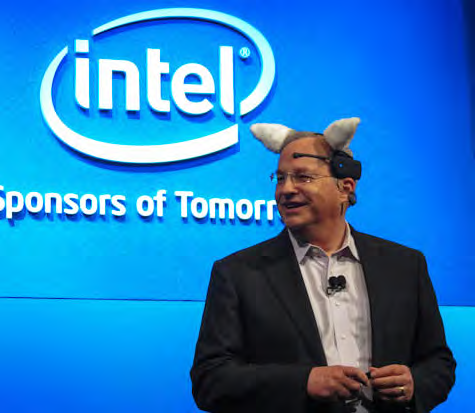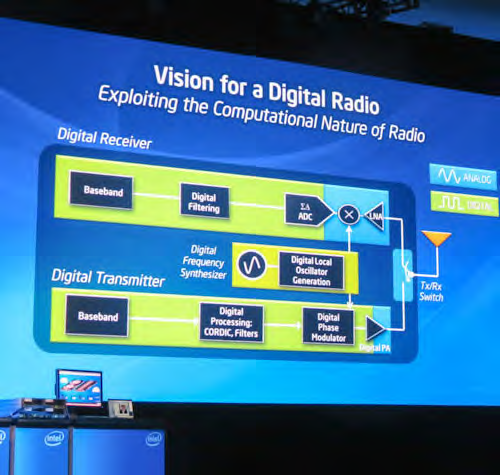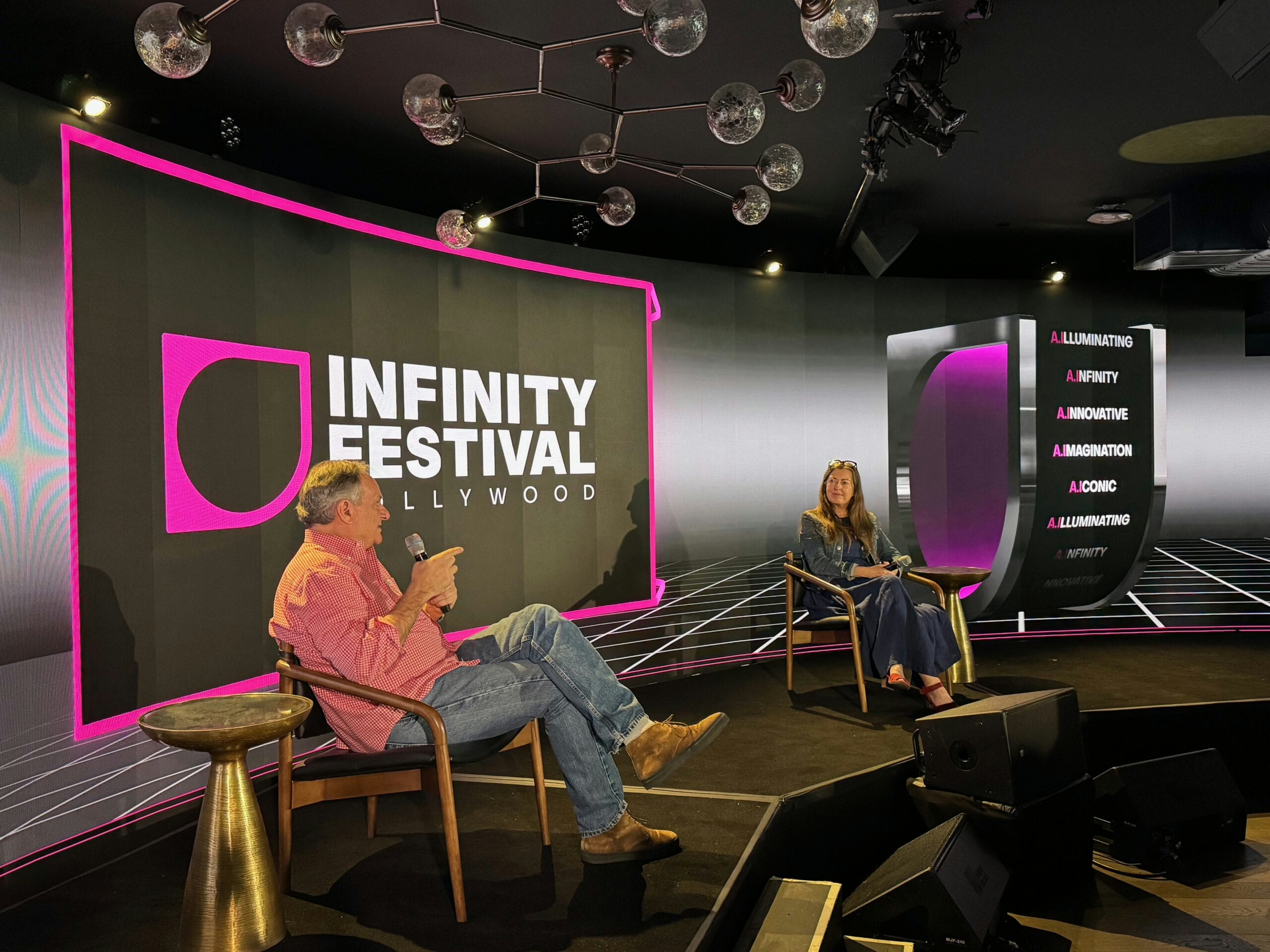Ten years after the famous Radio Free Intel speech, the current CTO says ubiquitous radio for the digital world is really, truly just around the corner.
By Kathleen Maher
Justin Rattner has one of the greatest jobs in the universe. Justin Rattner has one of the scariest jobs in the universe. Intel’s CTO has a big role in planning Intel’s development path for the future, and so, in a way, he plays a big role in planning all our futures. Pretty scary, right?

As we learned this year at Intel Developers Forum (IDF), Rattner is gathering many ideas about the future, and he’s not limiting himself to input from the rest of the priests in his caste, he’s also been reaching out to a wide range of people for their ideas on the future. Rattner’s broadmindedness was on obvious display when he arrived to the IDF stage to close the conference wearing a pair of pink cat ears from NeuroSky, which were supposed to respond to Rattner’s emotional vibes and even fold down when he was suitably relaxed. But, as he pointed out, standing on the big IDF stage was probably not the most relaxing environment to test the ears’ effectiveness.
The ears, he said, were a nice example of perceptual computing, but, he said, he really wanted to talk about something else. And with that, Rattner returned to one of the most compelling addresses ever given by an Intel CTO at IDF or anywhere, Pat Gelsinger’s Radio Free Intel speech ten years ago.
Radio everywhere
Gelsinger’s premise was that radios will be everywhere and in everything, and he said Intel would be building them. Rattner said he agreed that “everything that computes, connects.” But, in one of several sly swats at Gelsinger, Rattner said he doesn’t like to present topics at IDF unless it’s actually working, and so, he says, now is a better time for the topic because there is stuff Intel is doing with radio technology that actually works. Rattner promised that the work being done would eventually lead to an Internet of things; that technology is almost ready too—“we may be talking about that in a year or two.”
When Gelsinger proposed digital radios, Intel was a long way away from building radios, and, Rattner noted that whole “free” thing gave the Intel corporate powers the heebie-jeebies. The issue of radios, whose got them and where to they go, crops up from time to time, and the conventional wisdom shifts. The idea of integrating radios into processors seems logical, especially for a company like Intel, which wants to make the x86 the only processor you’ll ever need.

And as a matter of fact, it was a logical idea for TI, too. They wanted to make the ARM-based OMAP the only processor your phone would ever need. But integrating everything into one processor turned out to be a case of sailing into some very rocky shoals, and TI has foundered.
The problem with radios is that the technology is primarily analog. Intel took apart the problem so that they could find the pieces that could be digital and they left parts that will have to be analog. Rattner admitted that there are some parts that may always be analog.
Gelsinger’s talk, said Rattner, sent them down the path of integrating radios, and “thus began our quest to the impossible. It’s taken us ten years, but I think we did it,” he said. What they have done is “Rosepoint,” a prototype chip design that incorporates a wireless Wi-Fi radio into a processor. It’s a 32-nm SoC with a Wi-Fi transceiver and two Atom cores on the same die. Intel doesn’t do anything without a standards body at its command. In this case the WiGig Alliance will bring technology developers like Intel together with application developers who will create products and give the technology a reason to live.
WiGig is the driver. The specification will enable high-speed close-up transmission from device to device, for instance, from a phone to a TV or from an Ultrabook to a docking station. The WiGig specification calls for speeds of up to 7 Gbps. The president and chairman of WiGig, Dr. Ali Sadri, joined Rattner on stage to demonstrate the WiGig standard at work, and it did work. Rattner made it all ever more real when he performed the ceremonial gesture of raising the wafer high for all to see. (We’re beginning to think that Intel has stage wafers they can pull out for any occasion, but that’s probably unworthy of us.)
It’s the WiGig alliance that is one of the most compelling arguments for WiGig. The Board of Directors has all the right members including AMD, Broadcom, Cisco, Dell, Huawei, Intel, Marvell, MediaTek, Microsoft, NEC, Nvidia, Panasonic, Qualcomm, Samsung, Toshiba, and Wilocity. Intel’s director of the Intel Mobile Wireless Group, Dr. Ali Sadri, heads the WiGig organization.
Sadri told the audience that WiGig-based devices will result in an “unleashed” environment for the laptop and end its dependencies on wires. The connections for which we carry USB-based cables will be enabled by WiGig, and we will all be traveling with many fewer wires.
Look at the hand
So, if you’re getting the drift of where Intel is going, you’re seeing processors everywhere, computers everywhere until they’re all around us, always on, always sensing. But the magical vision of the Majority Report, the Spielberg movie that proposed a future in which we are always connected and always watched, has to start somewhere. Never mind that we seem to want this future even though Spielberg was painting a dystopian vision.
In Intel’s world, the future lies with the Ultrabook, which will be so wonderful and come in so many shapes and sizes that we’ll have a reason to carry some kind of Ultrabook around with us always. So, what if we have our new best friend with us in a coffee shop and we get up to get our coffee, thoughtlessly leaving the machine alone and unattended?
Intel has already talked about the ability of motion sensors to shut the machine down. You put your machine down, it detects you’re not using it and it locks. But now you come back with your coffee, and you want to get back to what you were doing. Ah well, Intel’s Sridhar Iyengar came on stage with the answer: biometric sensing using the device’s camera to identify your hand, which with its pattern of veins and lines is apparently unique even to a camera.
In the future, we’ll be able to wave at cameras to identify ourselves and open doors or initiate transactions.
Rattner told the audience, “This is my seventh IDF keynote,” and he said that the subjects have changed from talking about silicon to talking about platforms. For instance, he said seven years ago, he talked about Core technology, but this year he hoped the audience understood that Intel’s ambitions have progressed to trying to create “great experiences across the entire computer continuum.”
As Rattner says, it’s all part of a continuum, and that continuum starts at home and in the coffee shop and goes all the way up to the monster servers feeding phones, and games, and retail. As it becomes digital, it becomes manageable— for good or evil.





